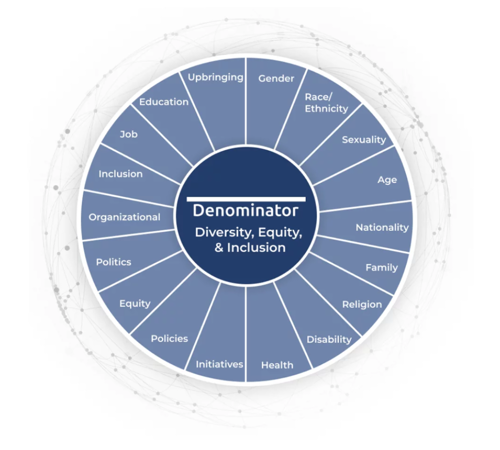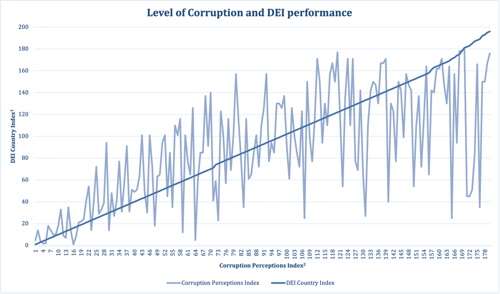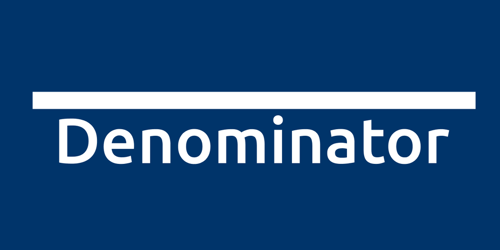8 March 2023
Corruption - the abuse of entrusted or public power for private gain - is a major obstacle for sustainable economic development in many parts of the world. It enforces wealth disparity and inequitable access to public resources and enables a raft of financial crimes, including modern slavery and human trafficking, the illegal wildlife trade, drugs and weapons trafficking, and fraud.
Diversity, Equity and Inclusion (DEI - or EDI, as it is sometimes known) - covers multiple different dimensions. Gender, race, ethnicity, age, engagement, opportunity and disability are some of the more visible aspects - although the list is much longer.
There’s an intuitive link between corruption and DEI: by its very nature, corruption excludes certain strata or segments of the population from public services and resources, leading to an unequal distribution of societal power, wealth and opportunity - and a less diverse, equitable and inclusive society. For International Women’s Day, Themis and DEI data and ratings provider, Denominator, therefore decided to undertake some statistical analysis into countries’ perceived corruption and DEI rankings, to understand the relationship between the two.
Many DEI efforts focus on just one or two DEI dimensions but Denominator believes this approach to be reductive or simplistic - so whilst this piece of research is in celebration of International Women’s Day, and we’ll predominantly discuss gender and corruption, we’ve analysed and ranked countries on DEI through a broader dimensional lens.
Illustration 1: Denominator’s 15 dimensions of DEI

Source: Denominator
With a holistic approach to DEI, we ran statistical analysis on Denominator’s DEI Country Index (consisting of two main components: a macro country score based on performance across 55 DEI indicators and companies’ aggregated DEI performance in each country, to capture dual levels of DEI performance and behaviour) against Transparency International’s recently released 2022 Corruptions Perceptions Index (CPI), which ranks 180 countries and territories around the world by their perceived levels of public sector corruption, scoring them on a scale of 0 (highly corrupt) to 100 (very clean).
Globally, we found a strong inverse correlation between corruption and DEI in terms of country rankings; as corruption decreases, DEI increases. With a statistically significant relationship between the two rankings, this might be understood as a bidirectional - even cyclical - pattern; those that are excluded and discriminated against in more corrupt economies find barriers to participating meaningfully in business or politics in a manner that would improve DEI whilst diversifying the homogeneity of such forums, thereby helping to tackle or dilute these corrupt practices.
Considering this data at a jurisdictional level, those countries ranked in the top 25 on both the CPI and DEI indices include Sweden, Denmark, Finland, Norway, Iceland, the Netherlands, Ireland, New Zealand, Australia, France, the United Kingdom, Belgium, the US and Germany. It’s worth noting that in many of these countries which score highly on DEI - such as those in Scandinavia - there isn’t necessarily a high level of diversity in every measure (for example, race) but first, this country level diversity data is accounted for in the statistical analysis and second, individuals from diverse groups in these countries may still be treated more equitably and inclusively.
Conversely, countries ranking in the bottom 25 on both the CPI and DEI indices include Yemen, Chad, Iraq, the DRC, Somalia, South Sudan, Syria, the Congo, Eritrea, Sudan, Equatorial Guinea and Guinea Bissau. Many of these countries are affected by instability and conflict, which are both caused by and provide greater opportunity for corruption (Transparency International notes that instability, conflict and corruption are ‘profoundly intertwined’).
Illustration 2: As countries’ level of corruption decreases, DEI performance increases

Note: Country placing on both rankings, where 1 is the highest DEI performance and the lowest level of corruption
Source: 1Denominator, 2Transparency International
Although many marginalised groups feel the effects of corruption keenly, they may do so in different ways, dependent on unique socio-economic, cultural, geographic, legal and institutional factors. Law enforcement officials are known to use dating apps to entrap and extort money from the LGBTQIA+ community in Russia, for example, where same-sex intimacy is illegal; some marginalised communities inhabit specific geographies and are more vulnerable to corrupt land-grabbing; and women may be at higher risk of sexual extortion. Compound identities, where individuals are members of multiple marginalised groups (for example, being part of the LGBTQIA+ community and an ethnic minority), may expose them to even more corrupt practices.
Turning to gender specifically, evidence shows that women often perceive and experience corruption differently to men, in part due to the unequal power relations between the two in many parts of the world. When corruption limits women’s voices and their access to public resources and education, it can reinforce social, cultural and political discrimination and this unbalanced, inequitable power dynamic.
In addition, women, as the typical primary caregivers of the family in many parts of the world, are generally the primary accessors of education, health and other public services and can therefore suffer disproportionately when these resources and services are diverted via corruption. Furthermore, in some societies, women are less economically able to pay bribes - because they are not responsible for family income and finances, for example - denying them access to services which are only accessible through financial inducement or forcing them to acquiesce to other demands, such as sexual extortion (the United Nations has even referred to sex as a “currency of corruption”). In this way, corruption can affect education, health outcomes and mortality rates for women; for example, Transparency International published research in 2013 indicating an exponential increase in the number of mothers that die during childbirth in countries with a higher incidence of bribery, as well as in girls missing out on secondary education.
However, having more women in positions of power - contributing to greater DEI - has been shown to correlate with a lower incidence of corruption. In 2001, for example, a World Bank study analysed the proportion of women in national legislatures against government officials’ likelihood of demanding special payments over a 50-year period across 100 countries. The correlation was significant: the greater the proportion of female legislators, the less likely a country’s top officials were to demand bribes - a pattern which persisted even when the authors accounted for other variables which could have skewed the analysis, and when other measures of corruption were assessed.
This seminal study considered the notion that women were fairer and less corrupt than men in and of themselves, something which subsequent researchers criticised. They urged against advocating for women’s participation in politics and business as a means of fighting corruption (as an ‘anti-corruption force’) rather than as a goal in itself and cautioned against reductive thinking - that there are innate differences between the sexes and that women are less risk averse than men, for example. Instead, they argued that the existence of more women in positions of power was indicative of a gender equality and wider DEI enabled by democracy; that democracy was responsible for both the gender inclusion and the lower incidence of corruption.
Indeed, follow up studies have suggested that the correlation of more women in positions of power and lower corruption is context-specific, and that the strength of the rule of law, freedom of the press and the existence of free and fair elections are stronger indicators of low corruption (although some research has also shown that women in positions of power or parliament tend to speak up more for the interests of marginalised and vulnerable communities than their male counterparts).
The United Nations Office on Drugs and Crime has a motto: “A more inclusive society is a less corrupt society”. Under this banner, their experts are looking into how including under-represented groups in decision-making processes could lower corruption risks and ultimately benefit more diverse groups of citizens, stressing that corruption is one of the biggest obstacles to poverty reduction and sustainable development. By its very nature, diversity breaks down and dilutes the ‘collusive networks’ on which corruption thrives, wherein more homogenous groups prioritise their own and exclude others - but it is important across multiple attributes for many other reasons; at both a country and a company level. Awareness of and emphasis on DEI is increasing but there is more to do, and the associated benefits - like innovation and productivity - are evidence for companies as much as they are for wider culture, society and democracy.
Denominator provides fact-based data and standards to DEI covering more than 1.7 million public and private companies, 85+ industries and 190+ countries on 650+ DEI specific data variables. Their data and analytical insights drive the most comprehensive DEI rating models and indexes, creating the global standard for measuring DEI performance.
